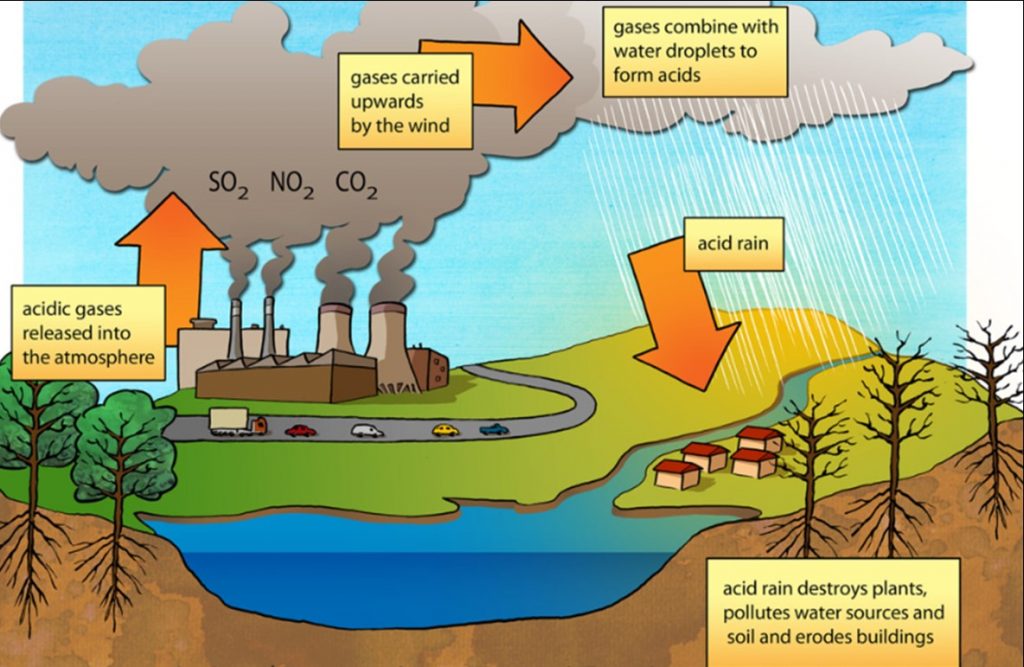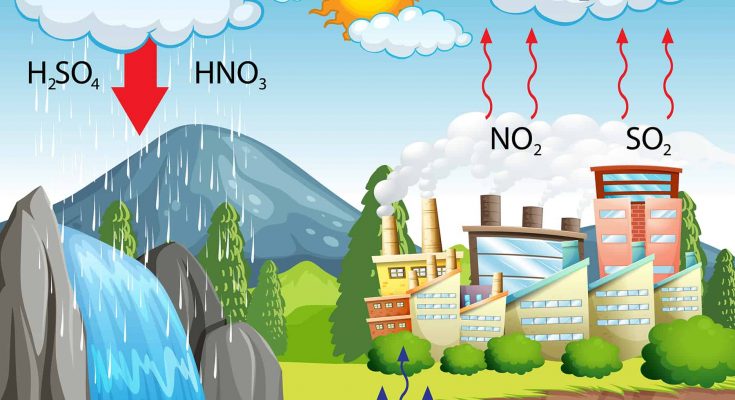Table of Contents
Acid Rain Definition
Acid rain refers to the precipitation that carries excessive amounts of acids, making the rainwater more acidic than usual. This phenomenon is primarily caused by the release of certain pollutants into the atmosphere, such as carbon dioxide (CO2), sulphur dioxide (SO2), and nitrogen dioxide (NO2).
Formation of Acid Rain
Origins of Acids-
- Pollutants like carbon dioxide, sulphur dioxide, and nitrogen dioxide are released into the air from various sources such as vehicles, industries, and combustion processes.
- These pollutants dissolve in raindrops, forming carbonic acid, sulfuric acid, and nitric acid, making the rain acidic.
Effects of Acid Rain-

On Buildings and Monuments-
- Acid rain can corrode metals and deteriorate stone and paint on buildings and historical monuments, causing them to lose their structural integrity and aesthetic value.
Also Check – The Effects of Acid Rain on Monuments
On Plants and Animals-
- It can harm vegetation by damaging leaves and roots, affecting the overall growth and survival of plants.
- Aquatic life can also be adversely affected due to the acidification of water bodies, disrupting the survival of fish and other aquatic organisms.
On Soil-
- Acid rain can lower the pH of the soil, affecting the availability of essential nutrients and hindering plant growth.
Also Check – NCERT Exemplar Solutions- Class 7 Science Chapter – 5- Acids, Bases and Salts
Components of Acid Rain
- Carbonic Acid- Formed by the dissolution of carbon dioxide in rainwater.
- Sulfuric Acid- Produced when sulphur dioxide dissolves in rainwater.
- Nitric Acid- Formed by the dissolution of nitrogen dioxide in rainwater.
Points to remember for Revision
- Acid rain is caused by the absorption of atmospheric pollutants like carbon dioxide, sulphur dioxide, and nitrogen dioxide by rainwater, leading to the formation of various acids.
- This phenomenon has detrimental effects, leading to the erosion of buildings, harm to vegetation, and negative impacts on aquatic ecosystems.
Also Check – Rapid Revision – Class 7 Science – Chapter 5-Acids, Bases and Salts
Also Check – Chapter 5- Acids, Bases and Salts-Class 7 Question and Answer (Long)
Also Check – Chapter 5- Acids, Bases and Salts-Class 7 Question and Answer (Short)
Also Check – NCERT Solutions For Class 7 Science Chapter 5 – Acids, Bases and Salts
Also Check – Class 7 science -Chapter 5-Acids, Bases and Salts – Definition and Explanation of Important Keywords
Also Check – Class 7 science -Chapter 5-Acids, Bases and Salts- Complete Notes
Also Check – Chapter 5- Acids, Bases and Salts-Class 7 Question and Answer (Fill in the Blanks)
Also Check – Chapter 5- Acids, Bases and Salts-Class 7 Question and Answer (MCQ)

